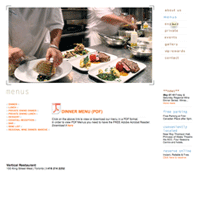Want to build a well-thought out, beautifully designed website? Here’s what you need to know
When it comes to being a successful restaurateur in today’s ultra-competitive marketplace, a marketing plan that relies solely on customer word-of-mouth is becoming increasingly passé. You might blame it on the computer-savvy Generation Y, a group constantly attached to their smartphones and always updating social networking pages.
But the reality of the situation, according to experts in the industry, is that consumers of all ages are turning to the Internet to make critical decisions on where they plan to eat out, or order in.
Restaurant websites have been around, in primitive stages, since the nascent days of the World Wide Web in the early 1990s; however, modern customers look for a more advanced experience online, before they ever consider booking a table. More importantly, they expect it.
“We have information and research that states that 90 per cent of people attempt to access a restaurant’s website prior to visiting that restaurant,” says Gary Lipovetsky, CEO of Toronto-based MenuPalace.com. “In this day it can’t just be about word of mouth. Without a website, you’re invisible.”
Since MenuPalace.com launched as a start-up in July of ’99, it didn’t take long for Lipovetsky and his team to realize restaurant operators weren’t just looking to be part of an online directory — they were looking for help with website design. He estimates that to date, the company has created anywhere from 700 to 1,000 restaurant websites through their in-house design services. MenuPalace charges between $1,000 and $6,000 for designing websites, depending on just how detailed they are.
“We link to the restaurant websites directly — websites that we help them design,” he says. “And our goal is to convert users to paying customers, to maximize the potential of that user turning into a reservation.”
Lipovetsky says that while the company’s three on-staff web gurus design in both HTML and Flash, trending in restaurant websites is moving from cluttered towards streamlined. “Right now, on the Internet, people want data, and a lot of the Flash elements and the fancy designs are getting a little excessive,” he says.
“Restaurateurs are naturally creative people — they’re artists and they’re chefs. A lot of times they’ll look at their website and try to make it graphically appealing, but there’s often a lot of unnecessary stuff on there. It should be tasteful. A lot of restaurateurs get carried away.”
To avoid a website bursting with too much movement and gaudy graphics, Lipovetsky suggests enlisting the help of a professional. They can take the creative vision and turn it into a workable model that delivers key information such as photography, menus, directions, contact information and online reservations in a simple and straightforward manner. Alternatively, another trend for those who don’t want to deal with a website is to join a restaurant directory group — such as MenuPalace.com’s new sister site torontorestaurants.com — with standard templates that display precise restaurant information. In other words, with website design it’s best not to DIY.
What can be done in-house, though, is updating your existing website. Keeping all materials on your website current is key to ensuring customers are connecting with your message and making a reservation. Sadly, this is an area Lipovetsky says even the best in the industry sometimes bungle. “Restaurateurs often forget about it, and they let this part go,” he says. “It’s not as bad as it was years ago, but they are certainly neglecting their online presence [once they have it].”
At Vertical restaurant in downtown Toronto, general manager Stefano Scodellaro knows that no matter how sleek and sexy a restaurant website looks, it’s simply bad for business to leave it with dated facts. “We find a lot of people are able to get all the information they need from our website,” he says, mentioning that it has been online since the opening days of the restaurant. “And that’s because the main thing we do is to keep it constantly updated.”
Scodellaro says these information updates take place at least every two days and are done in-house by someone with the appropriate training. “Our features change bi-weekly and when Chef drafts up a new menu, there’s really no delay in the process [of putting it online],” he says, adding that they also frequently post high-resolution photos of the latest dishes. “There are also online reservations because a lot of people prefer to do that sort of thing online as opposed to over the phone.”
Take a browse through the website and it’s clear how relevant website marketing is integral to Vertical’s business model. Not only is there a stylish interface, blending the bold colours of the logo with the minimalist white background and dark text, but every possible piece of information a guest could desire is available.
“The design and the way it is laid out really works for us. It is relatively straightforward,” says Scodellaro. “As for feedback, we get lots. [Our customers] are happy that all our info is correct, and they’ll often make reference to our photos.”
Engaging customers on a deeper level, however, is the next phase of restaurant web marketing. Pizza Pizza, a key player in the foodservice industry, is leading the pack when it comes to this phenomenon. Pat Finelli, Pizza Pizza’s CMO, has been with the company for 26 years. During that time he’s seen the company go from not having a website in the ’80s, to a very basic website in the ’90s, to re-launches in both 2004 and 2009.
“When I was a kid I didn’t even have a computer,” says Finelli, chuckling. “But people today are on the web all the time.”
One of Pizza Pizza’s most successful website components is its online ordering system. When the feature first launched in 2004, three or four per cent of all orders were completed through the website. Today, that number has grown to 21 per cent for pizza pizza online ordering, and 31 per cent online ordering for Pizza 73, its Alberta-based sister company.
“Last month we hit our millionth web order,” Finelli adds. “That was big for us.”
In 2004, Pizza Pizza spent approximately $200,000 for its website overhaul, and nearly $1 million for a subsequent redesign last year, a substantial investment.
Finelli credits the site’s success to features such as pre-ordering, which allows users to place orders well in advance of a party of special function, and personal menu creation. Using that feature, customers can save a personal order under a special name, which makes re-ordering for poker or movie night a snap.
“You can have it so that your favourite pizza is always there,” Finelli says, adding that plans are in the works to target the business lunch market with customizable office orders. On Pizza73.com, Finelli says they’ve even begun to introduce games to their online orders.
“We placed a game on the website called ‘Spin to Win’,” he says. “You could play to win a free litre of coke or an order of chicken wings or other items to add onto your next online order.”
For restaurateurs to stay on the cutting edge of what consumers want online, Finelli stresses the importance of looking towards younger employees for creative solutions.
“We have a really young and dynamic team here that is in with new media, Twitter and Facebook,” he says. “In my 26 years here, I was always focusing on advertising through radio, TV and print. But now we’re starting to see that the Internet is really the future of the younger generation. We’re starting to experiment with more frequency, with our department kicking things up a bit…and we’ll see the redemption in our numbers.”





















